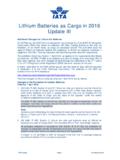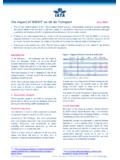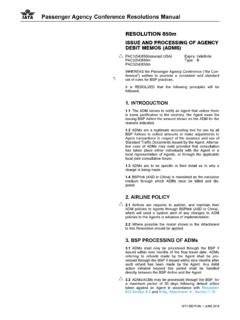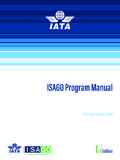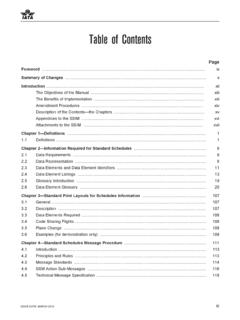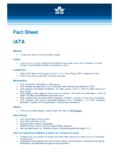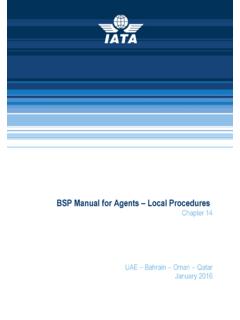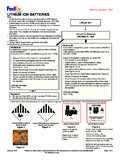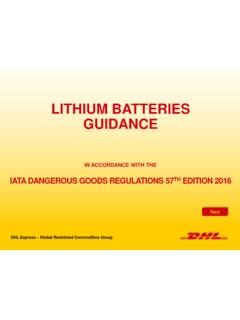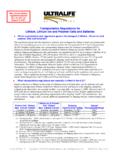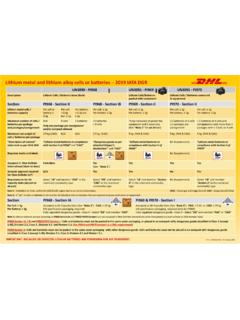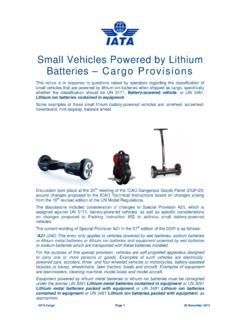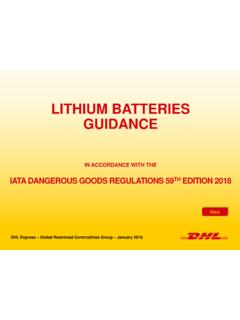Transcription of Lithium Batteries – Significant Changes on the Way
1 Lithium Batteries Significant Changes on the Way Lithium Batteries in all their forms have been the subject of regulatory review through the course of 2006 and 2007. The review process was driven in part by testing conducted by the United States Federal Aviation Administration (FAA) in 2004 to determine the behaviour of Lithium metal Batteries when exposed to a fire in a simulated aircraft cargo compartment. Lithium ion Batteries also came under scrutiny following the in-flight fire on a UPS DC-8 freighter aircraft that was on approach to land in Philadelphia in 2006. Adding to this was a number of fires involving laptop computer Batteries , which resulted in recalls of a large number of Lithium ion Batteries .
2 The fire testing conducted by the FAA identified that once ignited, Lithium metal Batteries have the capacity to self-propagate the fire by igniting adjacent Batteries until all of the Batteries were engulfed in the fire. Of greater concern was the identification that the Halon fire extinguishing system used in aircraft cargo compartments would not extinguish the fire and that the pressure pulse from the burning Batteries had the ability to breach the cargo compartment liner, which would potentially result in the spread of the fire into the aircraft. Lithium ion Batteries subjected to the same fire conditions did not self-propagate the fire and Halon was able to extinguish the fire.
3 With the UPS DC-8 fire, the post-crash investigation identified that laptop computers and spare Lithium ion Batteries were in ULDs at the source of the fire. However, the investigation was unable to conclusively determine the exact cause of the fire and so suggestions that the laptop Batteries were the cause of the fire is only circumstantial. Despite this, the hearing by the National Transportation Safety Board (NTSB) into the fire expressed some concern about Lithium ion Batteries and their fire potential, and the subsequent NTSB report on the accident has made recommendations to the US Pipeline & Hazardous Material Safety Administration (PHMSA) regarding the transport of Lithium Batteries .
4 United Nations Subcommittee of Experts on the Transport of Dangerous Goods (UN Subcommittee) Based on safety concerns of consignments of Lithium Batteries being transported unregulated through compliance with Special Provision A45 (UN Special Provision 188) and a desire by some regulatory authorities to regulate Lithium metal Batteries differently than Lithium ion Batteries , proposals were submitted to the UN Subcommittee of Experts on the Transport of Dangerous Goods during the 2005-2006 biennium. Proposals submitted and agreed to by the UN Subcommittee that have been implemented into the 15th revised edition of the Model Regulations that affect Lithium Batteries include: revision to special provision 188 (the UN equivalent of Special Provision A45 in the IATA DGR) to revise the determination for exception Lithium ion Batteries from a Lithium equivalent value to a Watt-hour value.
5 The special provision was also changed to require cells and Batteries to be in inner packagings that completely enclose the cell or battery, the standards for the outer packaging for cells and Batteries was enhanced and a new requirement was introduced for each package containing Lithium cells or Batteries to be marked to indicate the type of battery, Lithium metal or Lithium ion; addition of new UN numbers and proper shipping names for Lithium ion Batteries (UN 3480) and Lithium ion Batteries contained in, or packed with, equipment (UN 3481). The existing Lithium Batteries entries have been revised to become Lithium metal Batteries (UN 3090) and Lithium metal Batteries contained in equipment and Lithium metal Batteries packed with equipment (UN 3091).
6 ICAO Dangerous Goods Panel (DGP) In addition to the consideration of the Changes adopted into the UN Model Regulations, the ICAO DGP considered other specific proposals from Panel members and industry on the provisions applicable to the transport of Lithium Batteries by air. These proposals included: a ban on the transport of Lithium metal Batteries on both passenger and cargo aircraft; limitation of Lithium metal Batteries to Cargo Aircraft Only; removal of small Lithium metal and Lithium ion Batteries from special provision A45 with the exception of Batteries contained in, or packed with equipment; development of new packing instructions for small Lithium Batteries to incorporate all of the requirements from special provision A45.
7 Because of the complex nature of all of the proposed Changes to Lithium Batteries , the ICAO DGP established an ad hoc working group on Lithium Batteries to consider these proposals and to develop recommendations to the 21st Meeting of the ICAO Dangerous Goods Panel (DGP/21) that was scheduled to meet in November 2007. The ad hoc working group met for two days in Montreal in October 2007. In addition to Panel members and advisors, there were a number of representatives from the battery associations of Germany, Japan and the United States. While the ad hoc working group was able to make some progress, there was no final conclusion. Further work was then undertaken at DGP/21 to discuss the proposals to conclusion and to develop recommendations for adoption into the 2009-2010 edition of the ICAO Technical Instructions and consequently the 50th edition of the DGR.
8 The result of these extensive considerations is that from 1 January 2009 there will be extensive Changes to the requirements for shippers of Lithium Batteries . These Changes can be summarised as follows: 1. General. The packing instructions for Lithium Batteries have been reformatted, new packaging, documentation, labelling requirements (the new Lithium battery handling label is shown below), and new weight limitations have been adopted for small Lithium Batteries that meet the requirements of Special Provision A45. In addition, the detailed requirements of Special Provision A45 have been incorporated into the applicable packing instructions.
9 There is a requirement for shippers of small, excepted cells and Batteries , as follows: Any person preparing or offering cells or Batteries for transport must receive adequate instruction on these requirements commensurate with their responsibilities. In addition, the following new packaging and documentation requirements apply: cells and Batteries must be packed in inner packagings that completely enclose the cell or battery (retail type plastic blister packs meet this requirement); cells and Batteries must be protected so as to prevent short circuits. This includes protection against contact with conductive materials within the same packaging that could lead to a short circuit; each package must be capable of withstanding a m drop test in any orientation without: - damage to cells or Batteries contained therein; - shifting of the contents so as to allow battery to battery (or cell to cell) contact; - release of contents.
10 Each consignment must be accompanied with a document such as an air waybill with an indication that: - the package contains Lithium ion cells or Batteries ; - the package must be handled with care and that a flammability hazard exists if the package is damaged; - special procedures should be followed in the event the package is damaged, to include inspection and repacking if necessary; and - a telephone number for additional information. Lithium Battery Label (DGR Figure ) * Place for Lithium ion battery or Lithium metal battery , as applicable Minimum dimensions: 120 x 110 mm Colour: Black with red hatching on a contrasting background 2.
